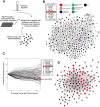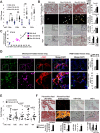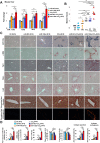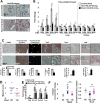A YAP/TAZ-miR-130/301 molecular circuit exerts systems-level control of fibrosis in a network of human diseases and physiologic conditions
- PMID: 26667495
- PMCID: PMC4678880
- DOI: 10.1038/srep18277
A YAP/TAZ-miR-130/301 molecular circuit exerts systems-level control of fibrosis in a network of human diseases and physiologic conditions
Abstract
The molecular origins of fibrosis affecting multiple tissue beds remain incompletely defined. Previously, we delineated the critical role of the control of extracellular matrix (ECM) stiffening by the mechanosensitive microRNA-130/301 family, as activated by the YAP/TAZ co-transcription factors, in promoting pulmonary hypertension (PH). We hypothesized that similar mechanisms may dictate fibrosis in other tissue beds beyond the pulmonary vasculature. Employing an in silico combination of microRNA target prediction, transcriptomic analysis of 137 human diseases and physiologic states, and advanced gene network modeling, we predicted the microRNA-130/301 family as a master regulator of fibrotic pathways across a cohort of seemingly disparate diseases and conditions. In two such diseases (pulmonary fibrosis and liver fibrosis), inhibition of microRNA-130/301 prevented the induction of ECM modification, YAP/TAZ, and downstream tissue fibrosis. Thus, mechanical forces act through a central feedback circuit between microRNA-130/301 and YAP/TAZ to sustain a common fibrotic phenotype across a network of human physiologic and pathophysiologic states. Such re-conceptualization of interconnections based on shared systems of disease and non-disease gene networks may have broad implications for future convergent diagnostic and therapeutic strategies.
Figures







Similar articles
-
Mechanosignaling through YAP and TAZ drives fibroblast activation and fibrosis.Am J Physiol Lung Cell Mol Physiol. 2015 Feb 15;308(4):L344-57. doi: 10.1152/ajplung.00300.2014. Epub 2014 Dec 12. Am J Physiol Lung Cell Mol Physiol. 2015. PMID: 25502501 Free PMC article. Clinical Trial.
-
Matrix Remodeling Promotes Pulmonary Hypertension through Feedback Mechanoactivation of the YAP/TAZ-miR-130/301 Circuit.Cell Rep. 2015 Nov 3;13(5):1016-32. doi: 10.1016/j.celrep.2015.09.049. Epub 2015 Oct 22. Cell Rep. 2015. PMID: 26565914 Free PMC article.
-
Arterial stiffness induces remodeling phenotypes in pulmonary artery smooth muscle cells via YAP/TAZ-mediated repression of cyclooxygenase-2.Am J Physiol Lung Cell Mol Physiol. 2017 Sep 1;313(3):L628-L647. doi: 10.1152/ajplung.00173.2017. Epub 2017 Jun 22. Am J Physiol Lung Cell Mol Physiol. 2017. PMID: 28642262 Free PMC article.
-
YAP/TAZ affects the development of pulmonary fibrosis by regulating multiple signaling pathways.Mol Cell Biochem. 2020 Dec;475(1-2):137-149. doi: 10.1007/s11010-020-03866-9. Epub 2020 Aug 19. Mol Cell Biochem. 2020. PMID: 32813142 Review.
-
Mechanobiology of YAP and TAZ in physiology and disease.Nat Rev Mol Cell Biol. 2017 Dec;18(12):758-770. doi: 10.1038/nrm.2017.87. Epub 2017 Sep 27. Nat Rev Mol Cell Biol. 2017. PMID: 28951564 Free PMC article. Review.
Cited by
-
Analysis of microRNA expression in patients with uric acid calculi.Urolithiasis. 2025 Apr 5;53(1):66. doi: 10.1007/s00240-025-01736-x. Urolithiasis. 2025. PMID: 40186757
-
Mitochondrial metabolism in pulmonary hypertension: beyond mountains there are mountains.J Clin Invest. 2018 Aug 31;128(9):3704-3715. doi: 10.1172/JCI120847. Epub 2018 Aug 6. J Clin Invest. 2018. PMID: 30080181 Free PMC article. Review.
-
Impaired angiogenesis in diabetic critical limb ischemia is mediated by a miR-130b/INHBA signaling axis.JCI Insight. 2023 May 22;8(10):e163041. doi: 10.1172/jci.insight.163041. JCI Insight. 2023. PMID: 37097749 Free PMC article.
-
Systems biology: An emerging strategy for discovering novel pathogenetic mechanisms that promote cardiovascular disease.Glob Cardiol Sci Pract. 2016 Sep 30;2016(3):e201627. doi: 10.21542/gcsp.2016.27. Glob Cardiol Sci Pract. 2016. PMID: 29043273 Free PMC article. Review.
-
Discerning functional hierarchies of microRNAs in pulmonary hypertension.JCI Insight. 2017 Mar 9;2(5):e91327. doi: 10.1172/jci.insight.91327. JCI Insight. 2017. PMID: 28289720 Free PMC article. Review.
References
-
- Dupont S. et al. Role of yap/taz in mechanotransduction. Nature. 474, 179–183 (2011). - PubMed
-
- Cordenonsi M. et al. The hippo transducer taz confers cancer stem cell-related traits on breast cancer cells. Cell. 147, 759–772 (2011). - PubMed
-
- Harvey K. F., Zhang X. & Thomas D. M. The hippo pathway and human cancer. Nat Rev Cancer. 13, 246–257 (2013). - PubMed
Publication types
MeSH terms
Substances
Grants and funding
LinkOut - more resources
Full Text Sources
Other Literature Sources

